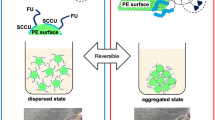A composition in the form of liquid polymer substance intended for embolization procedures was studied in in vivo experiment. The preparation was injected to rabbits into the femoral artery and abdominal aorta. The polymer composition exhibited properties previously demonstrated in vitro: strong adhesion to the vascular wall, high plasticity sufficient for embolization of the blood vessels, distal distribution, and the absence of toxic effects. The contrast substance remained in the embolus, which simplified its further localization. The agent underwent nether resorption nor organization. Injection of the agent in a volume of 0.1 ml was sufficient for embolization of an artery with a diameter of 0.1 cm. The polymer composition completely obstructed the vessel without inducing perforation of its wall. During the first day of the experiment, a slight infiltration of surrounding tissues with lymphoid cells was observed. By day 7, total dry necrosis of pelvic limb distal to the injection site was diagnosed. Inflammation of the surrounding tissues was shown histologically and was considered as the body response to impaired circulation and necrosis.
Similar content being viewed by others
References
Legon’kova OA, Stepanenko VS, Zhavoronok ES, Asanova LJu, Belova MS, Panov AV, Savchenkova IP, Chalykh AE. Surface energy and wettability of solid polymer films in modeling of properties of emboli for blockage of the blood vessels. Vopr. Biol., Med. Farm. Khimii. 2017;20(5):17-21. Russian.
Kedik SA, Legonkova OA, Zhavoronok ES, Panov AV, Asanova LY, Ogarkova PL, Dan VN, Sapelkin SV, Pokrovskij AV. Patent RU No. 2723991. Composition for embolisation of blood vessels. Bull. No. 17. Published June 18, 2020.
Embolization. Chabrot P, Boyer L, eds. London, 2014.
Gross BA, Du R. Diagnosis and treatment of vascular malformations of the brain. Curr. Treat. Options Neurol. 2014;16(1):279. https://doi.org/10.1007/s11940-013-0279-9
Legonkova OA, Asanova LY, Belova MS, Zhavoronok ES, Panov AV, Savchenkova IP. Mechanical properties of polymeric emboli for occlusion of blood vessels. Polymer Sci. Series D. 2018;11(3):307-311.
Ogilvy CS, Stieg PE, Awad I, Brown RD Jr, Kondziolka D, Rosenwasser R, Young WL, Hademenos G; Stroke Council, American Stroke Association. Recommendations for the management of intracranial arteriovenous malformations: a statement for healthcare professionals from a special writing group of the Stroke Council, American Stroke Association, Stroke. Circulation. 2001;103(21):2644-2657.
Vaidya S, Tozer KR, Chen J. An overview of embolic agents. Semin. Intervent. Radiol. 2008;25(3):204-215.
van Rooij WJ, Sluzewski M, Beute GN. Brain AVM embolization with Onyx. AJNR Am. J. Neuroradiol. 2007;28(1):172-177.
Varghese K, Adhyapak S. Therapeutic Embolization. Bangalore, 2017.
Author information
Authors and Affiliations
Corresponding author
Additional information
Translated from Byulleten’ Eksperimental’noi Biologii i Meditsiny, Vol. 170, No. 9, pp. 357-360, September, 2020
Rights and permissions
About this article
Cite this article
Legon’kova, O.A., Chupin, A.V., Ogannisian, A.S. et al. In Vivo Studies of a Liquid Embolic Compound. Bull Exp Biol Med 170, 360–363 (2021). https://doi.org/10.1007/s10517-021-05067-w
Received:
Published:
Issue Date:
DOI: https://doi.org/10.1007/s10517-021-05067-w



